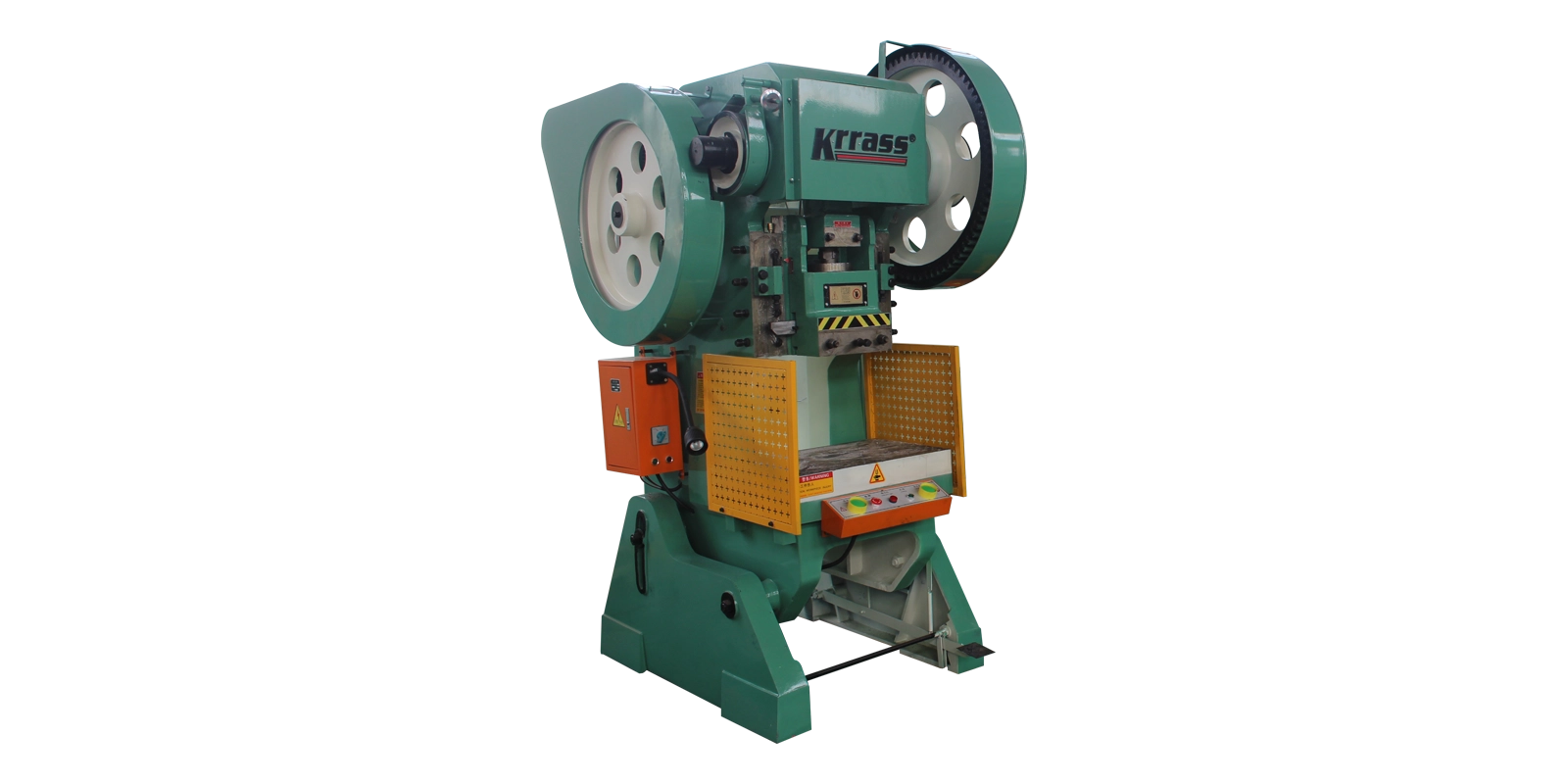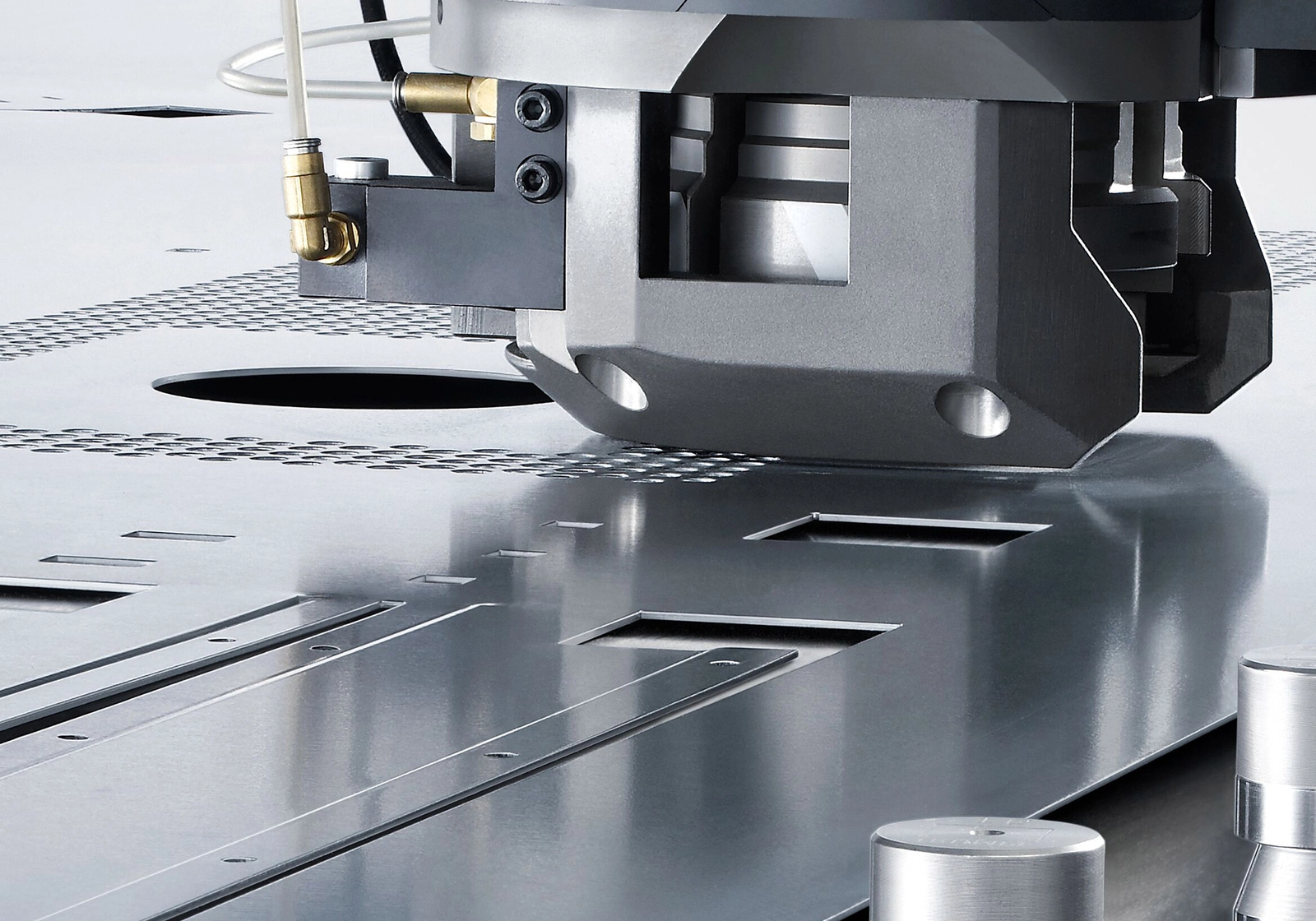At present, there are many types of Punching Machines available in the market, and they are applicable to a wide range of scenarios. According to statistical analysis, the models that are most commonly used by most consumers are CNC Hydraulic Press, Pneumatic Punching Machine, Inclinable Punching Machine and Deep Throat Punching Machine. Below, I will introduce them to you specifically through their working principles, structural composition, working principles, advantages and application scope.
Table of Contents
1.Hydraulic Press
Hydraulic Press is a type of stamping equipment that CNC technology with hydraulic transmission technology.

The working principle of Hydraulic Press:
Hydraulic transmission principle: Based on Pascal’s principle, which states that pressure is equal everywhere in a closed system. The motor drives the oil pump to operate, and the hydraulic oil in the oil tank is sent through the solenoid valve into the hydraulic cylinder. Due to the different areas of the pistons in the hydraulic cylinder, the small-area piston generates a smaller force, while the large-area piston can output a greater pressure, thereby driving the slider to move.
CNC Principle: By inputting processing instructions through the CNC system, the parameters such as the on-off state, flow rate and pressure of each solenoid valve in the hydraulic system are controlled, thereby precisely controlling the movement speed, stroke, pressure and holding time of the slider, and achieving the automation and precision control of the stamping process.
The structural composition of CNC Hydraulic Press:
Body structure: There are mainly two types: closed and open. The closed body has good rigidity and can withstand large impact forces, making it suitable for large-scale workpiece processing and high-precision stamping; the open body is convenient to operate, with three sides open, which is convenient for mold installation and debugging, and is often used for processing small parts.
Hydraulic system: It consists of components such as oil pump, oil tank, hydraulic cylinder, electromagnetic valve, and overflow valve. The oil pump pressurizes and conveys the hydraulic oil, the electromagnetic valve controls the flow direction and flow rate of the oil, the hydraulic cylinder converts the hydraulic energy into mechanical energy to drive the slider to move, and the overflow valve is used to regulate and stabilize the system pressure.
CNC System: It is the “brain” of the Punching Machine. It is usually equipped with an industrial computer or a dedicated CNC device. It has a human-computer interaction interface, allowing for the input and editing of processing programs, controlling various actions and parameters of the Punching Machine, and also enabling functions such as fault diagnosis and alarm.
Slider component: Connected to the piston rod of the hydraulic cylinder, it performs reciprocating linear motion under the drive of the hydraulic system. Its lower end is equipped with an upper die, and it works in conjunction with the lower die to carry out stamping processing on the sheet material. The motion accuracy and stability of the slider directly affect the quality of the stamped parts.
Feeding mechanism: Common methods include ball screw feeding and gear rack feeding. It is driven by a servo motor and can precisely control the feeding length, speed and position of the sheet material according to the instructions of the CNC system, achieving automatic feeding.
The advantages of CNC Hydraulic Press:
High processing accuracy: The CNC system can precisely control the position and pressure of the slider, with high repeatability positioning accuracy. This ensures the dimensional accuracy and consistency of the stamped parts, and the processing accuracy can reach ±0.01mm or even higher.
Pressure control accuracy: The hydraulic system can provide stable and precisely adjustable pressure. It can set and adjust the punching pressure within a certain range according to different processing materials and process requirements, meeting the needs of various stamping processes.
Adjustable movement speed: The sliding block’s descent speed, pressing speed and return speed can be flexibly adjusted through the CNC system. This not only enhances production efficiency but also meets the speed requirements of some special processes.
High degree of automation: It features automatic feeding, automatic mold changing, and automatic counting functions, enabling unmanned automated production. This not only enhances production efficiency but also reduces labor costs and physical strain, and minimizes the impact of human factors on product quality.
Long mold lifespan: Due to the precise control of pressing force and motion accuracy, the impact and wear on the mold are minimal, which helps to extend the mold’s service life and reduce the costs of mold replacement and maintenance.
The application fields of CNC Hydraulic Press:
Automobile manufacturing: It involves stamping processing for automotive body panels, chassis components, engine parts, etc., such as doors, engine covers, frame longitudinal beams, connecting rods, etc. This can meet the production requirements of large-scale and high-precision for automotive components.
Electrical Appliances: Components such as the casings, shielding covers, heat sinks, and connectors for electronic devices can be processed. They are suitable for the trend of making electronic components thinner and more precise. Examples include mobile phone casings, computer chassis, and transformer cores.
Hardware products: Widely used in the hardware industry, such as processing various hardware components like door locks, hinges, handles, tableware, kitchenware, etc. This enables the realization of complex shapes and processes in stamping, thereby improving production efficiency and product quality.
Aerospace: It is used for processing components in the aerospace field, such as aircraft wings, fuselage structural parts, engine blades, etc. The processing accuracy and quality of the materials in this field are extremely demanding. CNC hydraulic Punching Machines can meet these stringent processing requirements.
Appliance manufacturing: For components such as the shells, inner cavities, and supports of household appliances like refrigerators, air conditioners, and washing machines, the stamping and forming process can achieve large-scale automated production, ensuring the consistency of product quality.
2.Pneumatic Punching Machine
A pneumatic Punching Machine is a device that uses compressed air as the power source and is driven by an air system to complete the punching action through a slider. Its working process is based on the conversion of “air pressure energy → mechanical energy”. Pneumatic Punching Machines are widely used in lightweight punching scenarios due to their light weight, high efficiency, and low cost. Compared with mechanical Punching Machines and hydraulic Punching Machines, pneumatic Punching Machines have unique advantages such as high speed and low energy consumption, but they also have certain limitations. For example, the punching force is relatively small (usually not exceeding 100 tons), and the pressure stability is affected by fluctuations in the air source. They are not suitable for heavy plate and high-strength material heavy punching.

There are three types of pneumatic Punching Machines:
Manual pneumatic Punching Machine: Requires manual feeding and pressing the foot pedal switch to start, suitable for simple and small-batch processing (such as hole punching of hardware parts);
Semi-automatic pneumatic Punching Machine: Equipped with an automatic feeding mechanism (such as roller feeding, mechanical hand), only requires manual loading, with higher efficiency.
CNC pneumatic Punching Machine: Combining with the CNC system, it can program control the slider stroke, speed and feeding position, suitable for precise processing of complex shapes (such as the forming of electronic connectors).
The working principle of pneumatic Punching Machine :
Air source supply: Compressed air is provided by an external air compressor. After passing through filters, pressure reducers and other pneumatic components for treatment, the gas is made clean and the pressure is stable (the working pressure is usually between 0.4-0.6 MPa). Power conversion: Compressed air enters the cylinder (in a single-cylinder or double-cylinder structure), pushing the piston to move. Then, through the transmission mechanisms such as connecting rods and crankshaft, the linear motion of the piston is transformed into the up-and-down reciprocating motion of the slider.
Pressing operation: When the slider descends, it drives the upper and lower molds to close, completing processes such as punching, blanking, bending, and forming of the material; when the slider ascends, it returns to its original position relying on the return force of the spring or the cylinder, preparing for the next cycle.
Control and regulation: The on-off and direction of the airflow are controlled by solenoid valves, foot-operated valves or CNC systems, enabling the start, stop, speed adjustment and stroke control of the slider.
The structure composition of the Pneumatic Punching Machine:
Frame: Mostly made of cast iron or steel welding, providing rigid support. It is divided into open type (with large operating space, suitable for small workpieces) and closed type (with stronger rigidity, suitable for slightly larger loads).
Air source treatment components: Filter (removes water and impurities), pressure reducing valve (stabilizes air pressure), oil mist generator (lubricates pneumatic components).
Actuating components: Cylinder (provides power, has single-acting and double-acting types, double-acting cylinders can control forward and backward movement in both directions).
Control components: Electromagnetic valve (controls air flow direction), pressure relay (monitors air pressure, ensures safety).
Slide block and mold mounting base: The slide block is connected to the cylinder piston, the lower end installs the upper mold, and the motion accuracy is ensured through the guide rail; the worktable surface installs the lower mold, which can be adjusted in height according to requirements.
Operation and safety devices: Include foot pedal switch, two-hand start button, emergency stop button, protective cover, etc., to prevent accidental operation and potential safety accidents.
The advantages of the Pneumatic Punching Machine:
Fast response: The pneumatic system starts quickly, and the slider’s idle stroke speed can reach 100-300 times per minute, suitable for small and medium batch, high-frequency processing (such as punching of electronic components).
Low energy consumption: It only consumes compressed air during operation, and there is almost no energy consumption in the standby state. The operating cost is lower than that of the hydraulic Punching Machine.
Easy operation: The punching pressure can be controlled by adjusting the air pressure (the punching pressure is usually between 1-50 tons, suitable for light processing), no complex parameter settings are required, and beginners can easily master it.
High safety: When overloaded, the compressed air can automatically relieve pressure to avoid damage to the equipment or molds; combined with the photoelectric protection device, it can effectively prevent workplace injuries.
Simple maintenance: The pneumatic components have a simple structure and low failure rate. Daily maintenance mainly involves cleaning the air source, replacing the filter element of the filter, and lubricating the components.
Application fields of pneumatic Punching Machines
Electronic and electrical industry: hole punching for mobile phone casings, circuit board cutting, connector pressing, battery shell forming, etc.
Hardware products industry: stamping, bending, riveting of small hardware parts (such as screws, washers, hooks).
Toys and daily necessities: metal parts for plastic toys stamping, zipper head forming, tableware stamping, etc.
Automotive parts: batch processing of small automotive parts (such as snap fasteners, washers)
Medical devices: lightweight stamping of precision medical parts (such as needle holder seats, instrument casings)
3.Inclinable Punching Machine
The Inclinable Punching Machine is a Stamping press equipment with a tiltable body structure. Its core feature is that the worktable or the entire frame of the machine can be tilted within a certain angle range (usually 30° – 45°). By utilizing gravity to assist the automatic sliding of workpieces or waste materials, it has many advantages such as efficient material discharge, reduced manual labor, compact structure, flexible operation, lower cost, and easy maintenance. It is widely used in small and medium-sized simple stamping processing scenarios.
However, it also has limitations such as a relatively lower pressure capacity (typically 10 – 100 tons) and limited accuracy. The pressure is usually 10 – 100 tons, and it is not suitable for thick plates (such as those over 5mm) or high-strength materials. The tilting structure may result in slightly lower rigidity of the machine body compared to closed-type stamping machines. Long-term use may cause slight deformation, affecting the stamping accuracy (suitable for parts with an accuracy of ±0.1mm).

The working principle of the Inclinable Punching Machine:
Tiltable body design: The machine body is connected to the base through hinges or adjustment mechanisms, and can be tilted manually (for small machines) or hydraulically (for large machines). The tilt angle can be adjusted within the range of 0° – 45°. When tilted, the worktable forms a slope, and the processed workpieces or waste materials can slide off the worktable along the inclined surface, reducing the time for manual cleaning.
Mechanical transmission is the main method: Most tiltable stamping machines use a mechanical transmission system: the motor drives the flywheel to store energy, and through the crankshaft and connecting rod, the rotational motion is converted into the up-and-down reciprocating motion of the slider, driving the die to complete stamping (punching, blanking, bending, etc.). The stamping frequency is usually 100 – 300 times per minute, suitable for small-batch continuous processing.
The structure composition of the Inclinable Punching Machine:
Open structure, mostly “C-shaped” open machine body, with three open operation spaces on all sides, facilitating the loading and unloading of workpieces from different directions, especially suitable for manual or semi-automatic feeding of small parts (such as gaskets, small hardware parts).
The advantages of the Inclinable Punching Machine
The inclined function is the greatest advantage: the finished products or waste materials after stamping do not need to be manually cleaned. They slide into the collection box along the inclined tabletop by gravity, especially suitable for regular-shaped, lightweight parts (such as metal sheet products), which can increase the auxiliary operation efficiency by more than 30%.
The open design combined with the inclined feature results in a small equipment footprint and lower requirements for the operator’s skills. It is suitable for simple stamping tasks with small batches and multiple varieties (such as the blanking of small hardware parts).
The mechanical transmission structure is mature, with a manufacturing cost lower than that of hydraulic or CNC Punching Machines. Daily maintenance mainly involves repairing easily damaged parts such as flywheels and guide rails. The failure rate is low, making it suitable for small and medium-sized enterprises.
Applicable scenarios of the Inclinable Punching Machine
Applicable scenarios of the Inclinable Punching Machine
Small hardware products: blanking and punching of components such as gaskets, projectiles, and small hooks.
Light industry: simple shaping of toy parts, metal components for stationery, and small parts for kitchenware.
Electronic industry: primary stamping of small metal shielding covers and connector pins.
4.Deep Throat Punching Machine
The Deep Throat Punching Machine is a special type of punching equipment with a unique structure. Its core feature is that the “throat depth” of the machine (that is, the horizontal distance from the center of the slider to the vertical column of the machine body) is significantly greater than that of ordinary Punching Machines, enabling it to process large-sized and irregular-shaped workpieces.

The working principle of the Deep Throat Punching Machine
The working principle of the Deep Throat Punching Machine is essentially the same as that of a regular Punching Machine. Both rely on a power system, such as a motor driving a crankshaft, connecting rod, etc. mechanical structures, or a hydraulic system to generate pressure. This converts the rotational motion into the linear reciprocating motion of the slider, thereby driving the mold installed on the slider to exert pressure on the workpiece placed on the worktable, causing it to undergo plastic deformation or separation, and completing various punching processes such as punching, blanking, bending, and stretching.
The structural composition of Deep Throat Punching Machine
Ultra-long throat design: The throat depth is the key parameter that distinguishes deep throat Punching Machines from ordinary ones. The throat depth of an ordinary open-type Punching Machine is usually 200-500mm, while that of a deep throat Punching Machine can reach 600-2000mm or even larger. This design allows the workpiece (especially large plates and irregular parts) to be processed deeply inside the machine body, solving the problem that ordinary Punching Machines cannot handle large-sized workpieces due to insufficient throat depth.
Open C-shaped body as the main structure: Most deep throat Punching Machines adopt an open C-shaped structure, with one side of the body completely open. Combined with the ultra-long throat depth, large workpieces can be sent into the center of the worktable from the side, meeting the punching requirements for edges and middle areas (such as punching holes in large plates, bending of long-shaped parts).
Strengthened worktable: The worktable surface is large, usually over 1.5-3 meters in size, and is equipped with reinforcing ribs at the bottom, with strong support and capacity to bear the weight of large workpieces, avoiding deformation of the worktable during processing and affecting the punching accuracy.
Multiple transmission methods: According to the power type, they are mainly divided into mechanical transmission and hydraulic transmission. Mechanical transmission is driven by a motor, flywheel, and crankshaft, and the punching frequency is high, generally 50-200 times/minute, suitable for continuous processing of medium-sized tonnage; hydraulic transmission uses hydraulic cylinders for driving, with greater punching force, up to 300 tons or more, and the speed can be adjusted, suitable for slow punching of thick plates and high-strength materials, such as stretching and forming of large parts.
The advantages of the Inclinable Punching Machine
Super large workpiece processing capacity: With an extremely long throat depth, it can easily handle large workpieces wider than the machine body, such as edge punching of large steel plates, middle part stamping, continuous punching of long strip profiles, and local forming of special-shaped components.
High operational flexibility: The open structure combined with the deep throat design allows for the unimpeded loading and unloading of workpieces without being restricted by the machine body. The position of the workpiece can be adjusted from multiple directions, especially suitable for single-piece and small-batch customized processing, such as mold maintenance and production of large equipment components.
Wide process adaptability: The hydraulic deep-throat Punching Machine can adapt to different materials, such as steel plates, aluminum plates, copper plates, etc., and different thicknesses, from thin plates to plates over 20mm thick, meeting the processing requirements of various punching processes.
Applicable scenarios of the Inclinable Punching Machine
Automobile manufacturing: Used for the stamping and forming of large metal components such as car body frames, cabin parts, etc., such as the manufacturing of car doors, engine covers, frames, etc.
Mechanical manufacturing: Can process the bases and frames of large equipment, completing processes such as punching, bending, and forming, providing key structural components for mechanical equipment.
Hardware processing: In the hardware industry, used for processing various large hardware parts, such as large nuts, bolts, washers, etc., as well as some complex-shaped hardware accessories.
Building decoration: Applicable to the processing of large metal plates in the building decoration field, such as the stamping forming of ceilings, curtain walls, window frame edges, etc., to meet the diverse needs of building decoration.
5.The Comparison Of Punching Machine
| Type | Hydraulic Punching Machine | Pneumatic Punching Machine | Inclinable Punching Machine | Deep Throat Punching Machine |
| Power source | Hydraulic system, transmitting pressure through hydraulic oil; | High-pressure gas generated by compressor; | Usually mechanical transmission, with crank connecting rod as the working mechanism; | Mechanical transmission or hydraulic transmission |
| Pressure characteristics | High pressure, capable of reaching hundreds of tons or even higher, and the pressure can be precisely adjusted according to process requirements. | Relatively low pressure, generally suitable for small-tonnage stamping, usually within 50 tons or less. | The pressure varies depending on the model, generally being of medium and small tonnage, suitable for common metal sheet stamping. | It can provide a large pressure. Hydraulic deep throat punching machines can achieve large-tonnage stamping and are suitable for thick plate processing. |
| Speed | The running speed is relatively slow, but the new servo hydraulic Punching Machine has an improved speed. | It is fast, responsive, and capable of achieving high-frequency stamping. | The speed is generally below 200 times per minute. | The mechanical transmission deep throat Punching Machine is faster, usually within the range of 200 to 1000 times per minute. |
| Accuracy | High accuracy. The slider stroke and pressure can be precisely controlled through the hydraulic system, suitable for precision stamping processing. | It also has high accuracy, especially when equipped with high-precision pneumatic components, it can be used for precision part stamping. | There are two types of accuracy: general and precision. The ordinary models have relatively lower accuracy, while the precision models can meet certain accuracy requirements. | High accuracy. Most are precision models, and CNC control can ensure the consistency of processing accuracy. |
| Body structure | Mostly open C-shaped structure. For large-tonnage models, a closed guide rail frame structure is often used. | The body is usually made of steel plates through welding, with a simple and compact structure. | The body is typically made of high-strength cast iron and can be tilted at an angle of about 25°, which is convenient for waste to slide off. | With an open C-shaped structure, it has an extremely long throat depth, a large working surface, and is equipped with reinforcing ribs. |
| Applicable processes | Suitable for stamping of various metals and non-metallic materials, particularly proficient in processes such as stretching, forming, and bending of thick plates, and also applicable for punching, blanking, etc. | Mainly used for punching processing of metals and non-metallic materials, can also perform simple processes like shallow stretching, suitable for small part processing. | Applicable to various cold stamping processes such as cutting, blanking, punching, bending, and shallow stretching of metal sheet materials. | Applicable to punching, bending, forming of large plates, long-shaped profiles, as well as edge or internal stamping processing of large workpieces. |
| Automation level | Equipped with servo CNC system, enabling automatic control. It offers various operation modes such as adjustment, automatic, and semi-automatic. | It can be centrally controlled by PLC, allowing for point motion, inch motion, single and continuous stamping. The automation level is relatively high. | It can achieve single or continuous stroke through electrical control. When equipped with an automatic feeding mechanism, it can perform semi-automatic continuous stamping. | Mostly controlled by CNC, it can achieve fully automatic feeding, with a high level of automation. |
| Noise level | The operating noise is relatively high, but the new hydraulic Punching Machine has reduced the noise through optimized design and sound insulation measures. | The noise is lower, the exhaust treatment is simple, and it is relatively environmentally friendly. | The operating noise is similar to that of ordinary mechanical Punching Machine and is at a medium level. | The noise level is related to the transmission method; the noise of mechanical transmission type is relatively high, while that of hydraulic transmission type is relatively low. |
| Maintenance cost | The hydraulic system is relatively complex, resulting in higher maintenance costs. Regular replacement of hydraulic oil and maintenance of hydraulic components are required. | The structure is simple, with main components being cylinders and electromagnetic valves, etc. The failure rate is low, and the maintenance cost is low. | The main maintenance components are crank connecting rod mechanisms, clutches, etc. The maintenance cost is relatively low, but the cast iron body is heavy, making the operation of moving and handling during maintenance more troublesome. | The mechanical transmission part requires regular maintenance, such as lubrication and replacement of worn parts, etc. The overall maintenance cost varies depending on the equipment model and usage frequency. |





